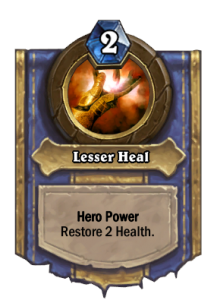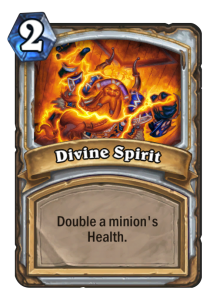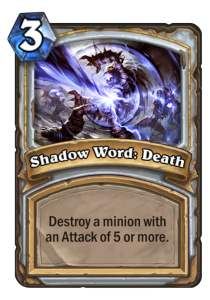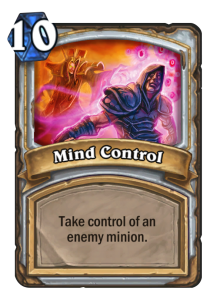Priests are the experts at healing and preservation. They serve the Holy Light, which in return grants them the power to restore the health of their wounded allies or even bring them back to life. Besides healing, Priests can also protect everyone around them with a variety of defensive, magical shields. They are the masters of life, but also the masters of death.
While Holy magic can be used for the offense, Priests have another weapon in their arsenal – Shadow magic. Not only can Priests assume the form of a Shadow, they can cast dozens of different spells that inflict pain and terror on the enemies. But such magic usually comes with a price – while the Priest remains in his Shadowform, no healing can be done.
Priests are one of the most interesting spell casters, as they walk a thin line between very contrasting schools of magic. But no matter whether they pick the light or the dark side, they are very formidable opponents.
In Hearthstone, Priest class is represented by the Anduin Wrynn. Players can also unlock an alternative, cosmetic Priest Hero – Tyrande Whisperwind.
Want to read about the story behind Anduin Wrynn? Head on over to Wowhead! You can also find the lore of Tyrande Whisperwind over there too!
Themes and Mechanics
 Priest’s Hero Power is Lesser Heal. It lets Priest heal any target – Hero or a minion – for two Health. It’s the best Hero Power if you want to keep your minions alive for as long as possible, which is often the basic game plan of the Priest class. It can counter or even outweigh any Hero Power that deals damage, but it can also be useless at times, especially in the early game when you don’t have good targets to heal (or you can’t waste your mana on Hero Power because you have other things to play).
Priest’s Hero Power is Lesser Heal. It lets Priest heal any target – Hero or a minion – for two Health. It’s the best Hero Power if you want to keep your minions alive for as long as possible, which is often the basic game plan of the Priest class. It can counter or even outweigh any Hero Power that deals damage, but it can also be useless at times, especially in the early game when you don’t have good targets to heal (or you can’t waste your mana on Hero Power because you have other things to play).
A mechanic that’s unique to Priest is copying cards from the opponent’s hand/deck, often simply called “stealing” (although you don’t exactly steal the cards because the opponent still keeps the original). Priests are really well known for playing around with opponent’s cards as much as with their own. The effects are somewhat random and can yield very weird results from time to time. Copying a random card from your opponent comes with a risk – you can get a card that requires some specific combo, synergy or another mechanic to work (e.g. if you steal the Rogue’s Deadly Poison, but you have no weapon, it’s completely useless). On the other hand, you might sometimes get a card that would normally be broken in your own deck. A good example is getting a Forbidden Healing in the deck that uses Auchenai Soulpriest – it’s potentially a 20 damage burn spell (12 damage if you want to play both on the same turn) and it’s not something that Priest is normally intended to do.
The copy effects come in different shapes and sizes – there are simple spells that just copy a card from the opponent’s hand/deck (Mind Vision, Thoughtsteal, Devour Mind), but also ones with some kind of restriction (Psionic Probe) minions with a similar effect (Crystalline Oracle), effect tied to a Discover mechanic (Drakonid Operative) or even a guessing mini-game (Curious Glimmerroot).
Learn more about Priest in World of Warcraft via Wowhead’s class guides: Discipline Priest Guide, Holy Priest Guide, or the Shadow Priest Guide!
Another mechanic (or maybe a “restriction” would be a better word in that case) tied to Priest are the cards that work only if a target has more or less than X attack. Those effects are generally really powerful and the cards are only balanced by those restrictions and the fact that they’re more situational. The two most popular cards like this are Shadow Word: Pain and Shadow Word: Death. Both are very powerful removals, but they might be dead from time to time, especially when an opponent plays a four Attack minions (which was always the bane of Priest). Other than removals, minion stealing effects also come with such restriction – both temporary (Shadow Madness) and permanent (Cabal Shadow Priest).
While not a big theme, Priests can also turn any healing to damage with cards like Auchenai Soulpriest and Embrace the Shadow. It might turn seemingly weak cards into a big AoE (Circle of Healing) or burn damage/removal (Flash Heal).
There are also some ongoing themes when it comes to the Priest cards. When new cards are released, there is a significant chance that some of them will fall into one of those categories:
- Dragons – The Priest’s main tribe. Ever since The Grand Tournament expansion, Dragon Priest has been a viable deck. While it wasn’t always popular, Priests received more and more cards to support this archetype. Finally, with Drakonid Operative from Mean Streets of Gadgetzan, it has become one of the most powerful decks in the game. While it has taken a big hit with the latest rotation, new Dragons released every now and then (. It should be safe to say that we might expect Priest to get more Dragon cards in the future – and even if we don’t, the Dragon theme will still be present in the Wild.
- Healing – Priest is a class that’s heavily focused on the healing aspect. Not only does its Hero Power heal, but there are multiple spells and minions that can do so as well. Here are some examples of the healing cards: Holy Fire, Holy Nova, Binding Heal, Greater Healing Potion, Darkshire Alchemist, Priest of the Feast. On top of that, some cards synergize with healing, for example, a staple Northshire Cleric which is the main Priest’s card draw or Mana Geode, which summons extra minions whenever it’s healed.
- AoE Removal – Priest are next to the Mage as masters of the AoE removals. Even though their Basic and Classic AoE cards aren’t that powerful (Holy Nova is one of the weaker AoEs in the game), Priest has been getting new stuff every now and then. Now, the class has a really powerful variety of AoE removals – between cards like Dragonfire Potion, Psychic Scream, Shadow Word: Horror, Duskbreaker, Shadowreaper Anduin (and of course Wild staples like Lightbomb and Excavated Evil), Priest has an AoE spell for every deck and every occasion.
- Buffs – Priest is a class that’s heavily focused on buffs, mainly when it comes to Health. While some cards also boost attack, it’s the health buffs like Power Word: Shield or Kabal Talonpriest that are really a staple in this class. Priests can also double the health of any minion with Divine Spirit and set a minion’s attack to be equal to its health with Inner Fire (those two are always played in the same deck as a part of a combo).
- Silence – There are more Priest Silence cards than Silence cards from all the other classes combined (or than Neutral Silence cards). Even though Silence is not a very popular mechanic, Priests still have the easiest access to it. They can Silence a single target (Silence, Kabal Songstealer), multiple targets (Mass Dispel) or their own minions (Purify). The last one is especially useful in the deck that focuses on playing minions with a “Can’t attack” tag (Ancient Watcher, Humongous Razorleaf) and “activating” them with Silence.
- Resurrects – One of the ongoing themes of Priest is being able to resurrect dead minions. It all started simply, with a Resurrect spell. Then in One Night in Karazhan, Onyx Bishop was released and made the whole theme even stronger. However, it only really took off in Knights of the Frozen Throne, thanks to the Eternal Servitude. More recently, another big resurrect card was released – Lesser Diamond Spellstone (which can revive up to four minions when it gets upgraded).
Strengths and Weaknesses
Strengths:
- Healing – Priests are hard to kill. Between their Hero Power, all the healing cards, all the buffs (which they can play on a Taunt minion) etc. only a big board or a quick combo can really do something against the Priest. Chip damage doesn’t really work because they will just heal out of it every turn. It makes Priest a natural counter of the decks that rely either on the burn damage over few turns (like the Standard Freeze Mage) or decks that want to finish the game with chip damage from their topdecked cards and Hero Power (Hunter decks).
- Combo Potential – Priests are historically one of the classes with the highest combo potential. The average Priest deck never really ran a lot of burn damage and that’s why the surprise factor was always pretty high. Right now most of the builds feature some kind of combo (either Prophet Velen + Mind Blast, or Divine Spirit + Inner Fire), so it’s not really that surprising, but it’s still powerful. With the right draws, Priests can easily pull out 20+ damage out of nowhere, which is incredibly powerful.
- High Value – Control Priest decks can be one of the highest value decks in the game. In a greedy meta, Priests might dominate simply because they’re playing both with their own cards and the opponent’s cards. Some of the “copy” mechanics come with a decent body and often result in a two-for-one (like Drakonid Operative – after the 5/6 body is answered, Priest is still one card ahead). Other cards like Thoughtsteal or Mind Control are also naturally two-for-one. And some cards, e.g. Lyra the Sunshard, can generate even more value out of nowhere.
Weaknesses:
- Weak Early Game – When Hearthstone first launched, Priest’s early game was so weak that the most common Turn 2 play was the Hero Power (basically much doing nothing). The situation has slightly improved recently with the introduction of Radiant Elemental (and Kabal Talonpriest in the expansion before), but it’s still far from perfect. Early game is still one of the Priest’s weak points and they often have to rely on the Neutral options to get through it (e.g. Doomsayer, Wild Pyromancer, and Injured Blademaster were all commonly played in Priest).
- Situational Cards/Restrictions – A lot of the staple Priest cards have restrictions – they can only be played on minions that have more or less than X attack. The cards are usually powerful (e.g. paying 3 mana to destroy any big minion you want with Shadow Word: Death), but because of those requirements, they might sit dead in the Priest’s hand for many turns without ever finding a target. Let’s say in a matchup against Aggro deck that simply doesn’t play any 5+ attack minions – the card is completely useless. Similarly, Cabal Shadow Priest is incredibly weak if you happen to play against Jade Druid. If there’s never a target with two of less Attack past Turn 6 you end up with a vanilla 4/5 for six mana.
- Value Tools Are Random – Most of the Priest’s value comes from the random effects, making it very hard to predict. Not only that but sometimes the value is simply nonexistent. For example, when you play Thoughtsteal against a Midrange Paladin. You might get Tirion Fordring and Spikeridged Steed, which is a game-winning outcome. But you might also get two cheap Murlocs, which are pretty useless. Since most of the Priest’s value comes from such random effects, it’s not uncommon that Priest gets a bunch of useless cards that never really come together. Not to mention that the other big value generators Priest uses (like Lyra the Sunshard or Medivh, the Guardian + Free From Amber combo) are also very random and might simply not work the way player wants them to.
Meta Decks and Strategies
Here are the Priest decks you can use on the ladder in the current meta. While not every deck listed here is high tier, they all should be viable options, especially to climb through the lower ranks.
- 0Circle of Healing1

- 0Silence1

- 1Binding Heal1

- 1Holy Smite1

- 1Northshire Cleric1

- 1Potion of Madness1

- 1Power Word: Shield1

- 2Mind Blast1

- 2Radiant Elemental1

- 2Shadow Visions1

- 2Shadow Word: Death1

- 2Shadow Word: Pain1

- 2Spirit Lash1

- 3Curious Glimmerroot1

- 3Kabal Talonpriest1

- 4Auchenai Soulpriest1

- 4Mass Dispel1

- 4Priest of the Feast1

- 5Dragonfire Potion1

- 5Raza the Chained1

- 7Prophet Velen1

- 7Psychic Scream1

- 8Shadowreaper Anduin1

Highlander Priest is one of the most iconic (and dominant) decks from the latest expansion. While it’s not a new archeytpe, as it was first introduced in Mean Streets of Gadgetzan, there was almost no reason to run it before – the few powerful cards were not worth the huge drop in the consistency, and Priest was the last class that needed Reno Jackson. Funnily enough, the deck become really powerful a few months after that card which made other classes run singleton decks rotated out.
The current power level of Highlander Priest comes from the new Frozen Throne Hero Card – Shadowreaper Anduin. Its Hero Power, Voidform, deals 2 damage, and refreshes every time you play a card. It’s a powerful Hero Power, true, but it wouldn’t be overpowered if it costed 2 mana. However, thanks to another Priest card – Raza the Chained – it’s possible to make it cost 0, which basically means attaching a “deal 2 damage” effect to every single card you play until the end of the game. As much as the deck suffers from some consistency issues (you really want to draw both cards, or else the deck is less powerful), it’s nearly unstoppable if it hits the right draws. With multiple tools to fend off the early game aggresison, and insane late game presence in form of 6 or more extra (free) damage every turn, it takes the spot as one of the best decks in the current meta.
- 5Barnes1

- 8The Lich King1

- 9Ysera1

- 10Y’Shaarj, Rage Unbound1

Control Priest has always been a fan favorite amongst control archetype decks. The idea of outlasting the opponent with the help of powerful heals and board clear showcases one of the most fitting “class fantasies” in Hearthstone.
During the last few expansions, Control Priest climbed up the meta-game tier lists, and with the release of Knights of the Frozen Throne, the greediest of all Control Priest lists, “Big Priest”, seems to be one of the only decks that can stay ahead in the current control-heavy meta-game
Inspired by the “Big Druid” list, Big Priest also heavily relies on powerful late-game minions and mechanics to activate them earlier in the game. Two of the main reason why this version of the deck became more than viable are two newly released cards. Eternal Servitude lets you choose one out of three minions that died during the game to be summoned again, and Shadow Essence, a 6-mana spell that summons a 5/5 copy of a minion from your deck.
These two spells activate the key card of every “Big” decklist: Barnes. While our friend from Karazhan was always able to pull big miracle minions out of the deck, their 1/1 versions always seemed to be too volatile to stay on the board for longer than one turn.
However, Eternal Servitude can revive these 1/1s and lets them spawn in full force. That combined with a lot of end-of-turn cards like The Lich King. Ysera and Y'Shaarj, Rage Unbound results in overwhelming value that can be easily reproduced turn after turn, even if the enemy uses heavy removal.
Dragon Priest has been an iconic Hearthstone deck in the past, from its inception as an “off-meta” deck with the release of the Blackrock Mountain adventure, to its dominance during the League of Explorers days. Blizzard tried to bring the archetype back with the latest release, Kobolds and Catacombs, with the introduction of Duskbreaker, a 4 mana 3/3 class dragon with a Battlecry that deals a 3 damage AoE to ALL minions. The development team commented that they wanted to take the famous archetype to a more controlling approach, but they seem to have miscalculated! Dragon Priest continues to play as a midrange, tempo deck and has gotten a number of tools to continue to put pressure on its opponents.
Spiteful Summoner Priest (also known as Satellite Priest, in honor of the first player to pilot it to high Legend) is a tempo deck based around it’s namesake, Spiteful Summoner and Grand Archivist. By excluding any low-cost spells, this deck ensures that both of those cards will target large spells like Free From Amber or Mind Control to create enormous minions or board swings much sooner than they would be normally possible.
Budget and Basic Decks
If you’re a new player without a big collection, you might be looking for a way to play Priest without spending a lot of your Dust on the Legendaries.
A Basic deck is a deck with only the starter cards. Every player can make it after unlocking the class and leveling it up to 10 (which unlocks every Basic card). It’s a best solution if you have just started playing the game – you can test each class without investing into it.
A Budget deck is a cheap deck with no Epics, Legendaries or Adventure cards. Budget decks only run the basic cards + Commons and Rares, which makes them relatively cheap and accessible even for players who have recently started. Average budget deck will cost up to 2,000 Dust to craft, but the number goes down heavily when you own some of the cards already. Even with a relatively small collection, you should be able to build one with just a few hundreds of Dust.
Basic decks are mostly meant for the Casual mode and up to Rank 20 in Ranked. Budget decks can easily be played up to Rank 10 in Ranked, while some of the better ones can even get you up to Rank 5.
This deck is a Midrange Priest with a slight touch of the Control play style. Full-fledged Constructed Priest decks are usually built around a bunch of different synergies and combos. However, since it’s not possible to do with the Basic cards, the deck is much more “honest” and, just like most of the others, tries to control the board and play on the curve. However, it already sneaks some of the Priest tricks like healing synergy (Northshire Cleric) or powerful, albeit situational removals (Shadow Word: Pain and Shadow Word: Death).
Priest’s Hero Power is very important. Depending on the situation, it might be the most powerful one among the Basic decks, but it also might be useless. Or more precisely, the same thing could be said about the whole deck. It’s insanely powerful and performs really well when you’re ahead – you can keep your minions alive forever, make value trades and draw cards at the same time. In the right scenario, it can outvalue any other Basic deck. But on the other hand, the moment it loses board control, all the synergies are gone, Hero Power becomes very weak and it might be really hard to come back without more expensive tools (like Lightbomb in the Wild or Dragonfire Potion in the Standard).
Basic Priest is probably a little bit harder to pilot than an average Basic deck, but at the same time it might be a good introduction into control decks and the concepts of value and card advantage.
Inner Fire Priest has kind of always been a fringe deck, but Silence versions of Priest have been powerful from time to time. You will also see the Inner Fire and Divine Spirit combo in Dragon Priest which takes advantage of their high health minions. The deck while not popular in Standard is one of the top decks in Wild!
Kobolds and Catacombs has not added a lot to this deck, but Unidentified Elixir is a pretty interesting card to play around with. Three of the four bonuses you can get (Elixir of Hope, Elixir of Life, and Elixir of Purity) are very good. The final one (Elixir of Shadows), while not great is still serviceable!
This wouldn’t be my first choice as a budget deck, but when it really fires on all cylinders it can be quite powerful. You can also transition from this deck to Dragon Priest.
Level-Up Rewards
Every 2 levels, up to level 10, you will get two copies of a Basic class card. A lot of those cards are staple, so it’s heavily advised to highly prioritize getting every class to level 10.
 |
 |
 |
| Level 2 | Level 4 | Level 6 |
 |
 |
| Level 8 | Level 10 |
Every few levels past level 10, you will be rewarded with a Golden version of one of the Basic cards. Leveling up past 10 doesn’t give you any competitive edge – all the rewards are cosmetic.













































